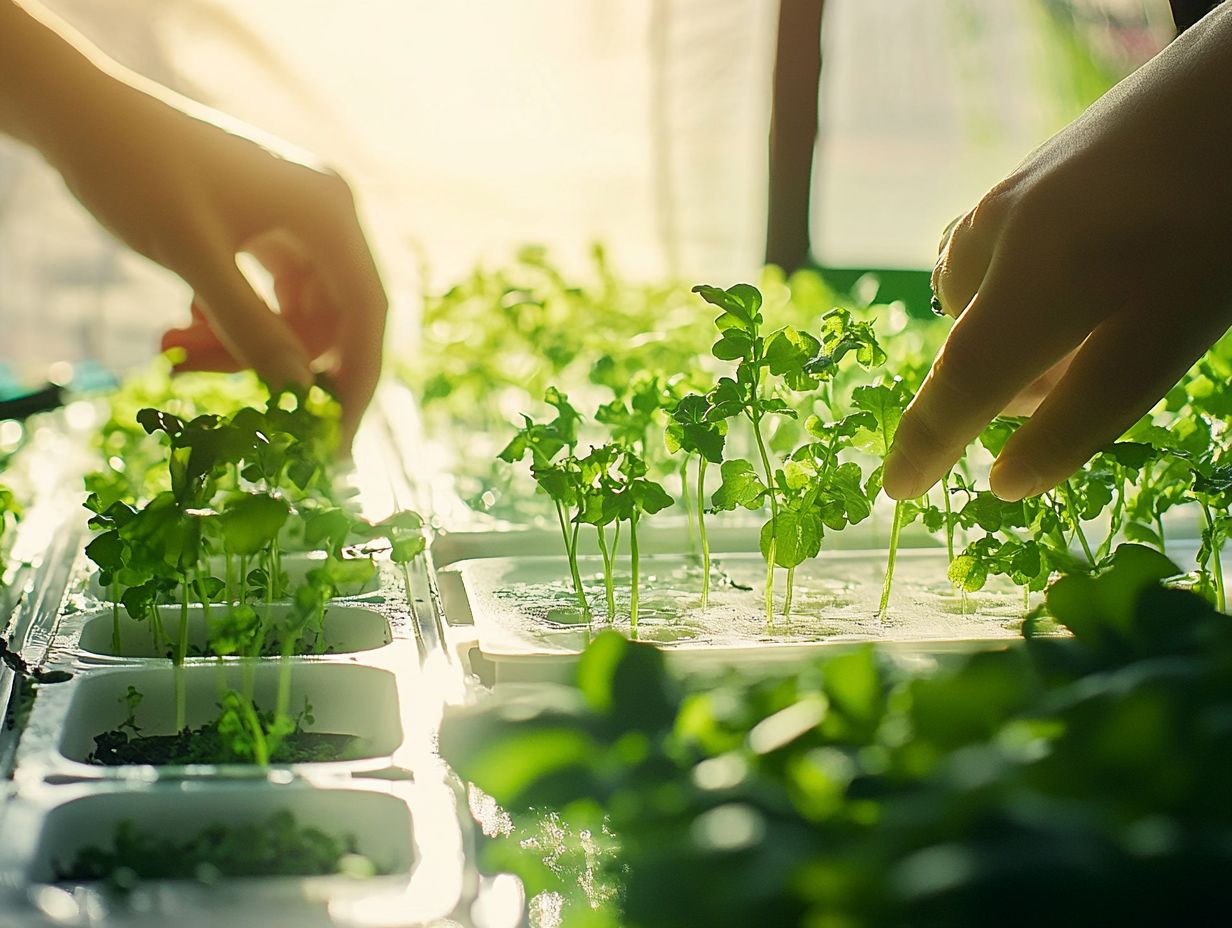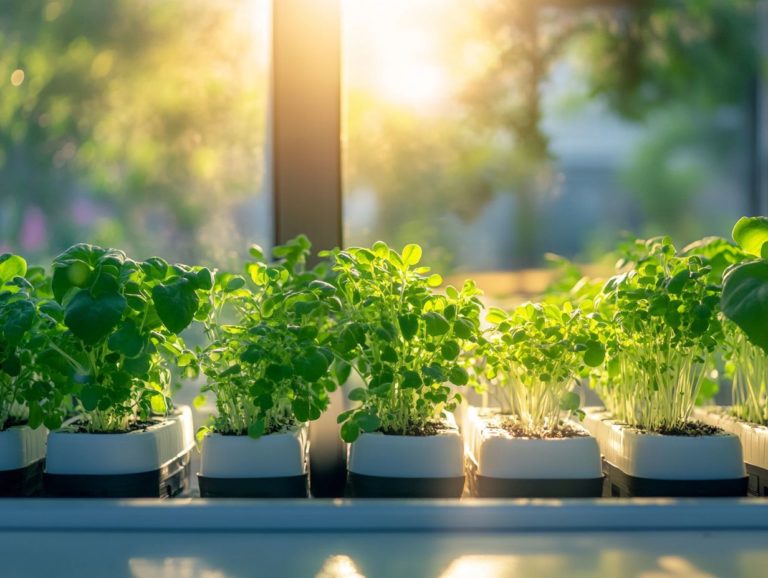How to Get Started with Hydroponic Systems
Curious about soil-less gardening? Hydroponics could be the answer you re looking for.
This innovative method offers numerous benefits for home gardeners who want to maximize space and yields in urban settings.
You ll explore different systems, including Deep Water Culture and Nutrient Film Technique. Discover which plants thrive in hydroponics and how to set up your own garden while overcoming common challenges.
This article provides all the insights you need to start your hydroponic adventure with effective plant-growing methods.
Uncover the secrets to successful soil-less gardening and get maintenance tips to enhance your experience!
Contents
Key Takeaways:

- Hydroponic systems offer benefits like faster growth, higher yields, and less water usage for home gardeners.
- Many hydroponic systems exist, each with pros and cons. Think about your space, budget, and the plants you want to grow.
- When setting up, choose plants like leafy greens that thrive in hydroponics. Gather all equipment, including a pH meter and net pots.
What is Hydroponics?
Hydroponics is a method for growing plants without soil. Instead, it uses nutrient solutions in water, perfect for efficient indoor gardening and urban farming.
This approach helps you grow fresh produce, like kale, lettuce, and basil, year-round in limited spaces.
The concept has roots in ancient civilizations, where it improved agricultural yields. By delivering nutrients directly to plant roots, hydroponics fosters rapid growth without the complications of soil.
Explore methods like Nutrient Film Technique and Aeroponics, which conserve water and maximize space. Whether you’re a novice or an expert, anyone can grow fresh herbs and vegetables at home.
As urban farming grows, hydroponics is key to building greener cities with healthier communities and easier access to homegrown food.
Benefits of Hydroponic Systems
Hydroponic systems offer many benefits, attracting home gardeners and urban farmers alike. They use water efficiently, boost crop yields, and allow for fresh produce cultivation in tight spaces.
Hydroponics also contributes to sustainable living by reducing the carbon footprint of traditional farming. Enjoy nutritious vegetables year-round!
Advantages for Home Gardeners
For you, the home gardener, hydroponic systems offer a wealth of advantages that transform the experience of cultivating fresh produce into something both efficient and pleasurable. These systems not only save space but also simplify the growing process, giving you better control over crucial factors like pH levels and nutrient solutions.
If you re an urban farming enthusiast, these systems allow you to maximize vegetable production, even in the confines of a small apartment or bustling city environment. You ll have easy access to your favorite greens, whether it s kale or basil.
Hydroponics helps plants grow faster, potentially yielding a harvest in as little as four weeks. You can forget about weeding and pest control! This method works great for busy people.
Start your garden today with easy systems like deep water culture or nutrient film techniques, both of which are cost-effective and user-friendly.
Incorporating LED grow lights can significantly boost growth, especially in areas where natural sunlight is scarce. By regularly monitoring and adjusting nutrient levels, you can maintain a steady supply of fresh produce, cutting down on grocery trips and fostering a more sustainable lifestyle.
Types of Hydroponic Systems
You ll discover a range of hydroponic systems, each thoughtfully crafted to cater to the diverse needs of growers and the specific requirements of various plants.
Among the most popular options are Deep Water Culture, Nutrient Film Technique, and aeroponic systems. These methods offer optimal nutrient delivery, fostering exceptional plant growth.
Vertical farming takes this effectiveness a step further, enabling urban gardeners to cultivate a bountiful harvest in limited spaces while maximizing yield and minimizing environmental impact.
Comparison and Pros/Cons

A thorough comparison of various hydroponic systems reveals notable advantages and disadvantages that can significantly influence your choices as a gardener. For example, while Deep Water Culture systems excel in oxygenating roots, they might demand more maintenance compared to Nutrient Film Techniques.
Knowing these pros and cons helps you choose wisely, tailoring decisions to your specific needs and growing environments, enhancing your home gardening experience.
Also, consider factors like initial setup costs, space requirements, and crop yields to clarify which system aligns best with your individual circumstances.
For instance, Wick Systems are often viewed as simple and low-tech, making them attractive for beginners, yet they may fall short in delivering rapid growth compared to others like Ebb and Flow systems, which facilitate faster plant development through their efficient flooding and draining action.
On the other hand, Aeroponic systems present a cutting-edge method with the potential to maximize yield, although their complexity might pose a challenge for some. Each system has its unique role in the hydroponics landscape, and recognizing these nuances can significantly elevate your gardening experience. For those interested in optimizing their setup, learning how to maintain your hydroponic growing system is essential.
Choosing the Right Plants for Hydroponic Systems
Selecting the ideal plants for your hydroponic system is essential for achieving success in indoor gardening and vegetable production.
Leafy greens such as kale, lettuce, and basil are frequently recommended, thanks to their quick growth cycles and strong market appeal.
By familiarizing yourself with the germination needs and growth conditions specific to each plant, you can cultivate a flourishing hydroponic garden. Learning how to set up a deep water culture system can also help you yield fresh produce with remarkable efficiency.
Best Plants for Hydroponic Growing
When exploring hydroponic growing, you’ll discover several standout plants perfect for both novice and seasoned gardeners. Leafy greens like kale, lettuce, and basil excel in hydroponic systems due to their rapid growth and minimal space needs. These plants are ideal for urban farming and home gardening. With a balanced nutrient solution, you can cultivate these greens year-round, ensuring a steady supply of fresh produce.
Beyond leafy greens, herbs such as cilantro and parsley thrive in hydroponic setups. They require moderate light and consistent moisture. These herbs need a slightly adjusted nutrient balance, with a focus on nitrogen for optimal leaf development. Consider adding fruits like strawberries and dwarf tomato varieties to your hydroponic garden for sweet, nutritious yields.
Success in hydroponics depends on maintaining stable pH levels and temperatures suited to each plant type. Regularly check nutrient levels and clean your system periodically to enhance growth and prevent disease, creating a flourishing hydroponic garden.
Setting Up a Hydroponic System
Setting up a hydroponic system requires careful planning and the right equipment to create optimal growth conditions for your plants.
Get essential materials such as a pH meter to monitor nutrient levels, an air pump to oxygenate the water, net pots for plant support, and a suitable growing medium like Rockwool or Perlite.
Assemble these components carefully to create an effective environment that supports germination and growth, paving the way for thriving plants.
Equipment and Materials Needed
To establish a successful hydroponic system, you’ll need a range of equipment and materials that set the stage for optimal plant growth.
Choosing high-quality components enhances plant health and creates a more efficient growing environment. For example, LED grow lights effectively mimic natural sunlight, promoting photosynthesis while keeping energy costs low.
Nutrient reservoirs and pumps are equally crucial for delivering essential nutrients. When selecting these items, focus on durability and energy efficiency to ensure long-term success.
Routine cleaning and monitoring nutrient solutions can help you avoid pesky issues like algae growth, ensuring your plants thrive wonderfully in their hydroponic setup.
Maintenance and Care for Hydroponic Systems and Vegetable Production

Proper maintenance and care are vital for achieving the best possible plant growth and ensuring a successful harvest.
Keep a close watch on nutrient levels, maintain pH balance using pH Down when needed and ensure water quality for a stable growing environment. Regular cleaning and equipment checks will help prevent common issues with hydroponic setups. For those starting out, consider the top hydroponic growing systems for beginners, allowing you to cultivate with confidence.
Tips for Optimal Plant Growth
To achieve optimal plant growth, monitor several key factors closely and adjust them as needed. Regularly check the nutrient solution’s composition, ensure appropriate pH levels with a reliable pH meter, and maintain adequate oxygenation with an air pump for healthy plant development. These practices will maximize your yields and enhance the quality of your fresh produce.
Providing the right light spectrum with energy-efficient grow lights significantly impacts photosynthesis, boosting growth rates. Temperature control is also essential; plants thrive best within a specific range that prevents stress and encourages vigorous development. Ensuring proper airflow reduces the risk of mold and strengthens plant structures.
Combine these elements, such as water culture systems and reliable hydroponic nutrients, to create a thriving environment where your crops can flourish, resulting in bountiful harvests and robust plant health over time.
Start your hydroponic journey today! Share your experiences or questions about hydroponic gardening below. Your thriving garden awaits!
Troubleshooting Common Issues
Troubleshooting issues in hydroponic systems is crucial for maintaining healthy plants and achieving successful growth. By identifying problems like lack of nutrients, pH imbalances, or water quality issues early, you can take proactive measures to restore optimal conditions for your plants.
Understanding these challenges enables home gardeners and urban farmers alike to cultivate thriving hydroponic gardens with confidence and ease.
Identifying and Addressing Problems in Hydroponic Systems
Identifying and addressing issues in hydroponic systems is essential for ensuring your plants grow successfully and yield optimally.
One common challenge is inadequate light levels, which can lead to stunted growth and elongated stems as plants stretch toward the light. Insufficient airflow can create stagnant conditions, making it easier for mold or pests to thrive.
Water quality is another important factor; high chlorine levels can impede nutrient absorption, causing symptoms like wilting or browning tips.
Regularly monitoring and adjusting environmental conditions including light intensity, air circulation, and water quality is essential. Utilizing hydroponic nutrient solutions and ensuring proper oxygenation will help you rectify these issues, ultimately protecting the health and productivity of your plants.
Frequently Asked Questions
What are hydroponic systems and how do they work?

Hydroponic systems are a method of growing plants without soil, using a nutrient-rich water solution. This approach allows plants to receive all the necessary nutrients directly, resulting in faster growth and higher yields.
What are the benefits of using a hydroponic system?
Using a hydroponic system can save space, water, and time compared to traditional soil-based gardening. It also allows for year-round growing and eliminates the need for weeding and digging.
What types of plants can be grown in a hydroponic system?
Almost any type of plant can be grown in a hydroponic system, including herbs, vegetables, fruits, and flowers. The key is to choose plants with similar nutrient requirements to ensure they thrive in the same water solution.
What equipment do I need to get started with hydroponic systems?
You will need a water reservoir, a pump to circulate the water, a grow tray, growing medium, nutrients, and lighting. Consider investing in a pH tester and a timer to automate the water and nutrient cycles.
Can I build my own hydroponic system?
Yes, many DIY hydroponic system designs are available online. You can also purchase pre-made kits that include all necessary components and assembly instructions.
How do I maintain a hydroponic system?
Maintaining a hydroponic system involves regularly monitoring water and nutrient levels, pH balance, and cleaning any debris or algae. Don t forget to regularly check and replace any worn out or malfunctioning equipment.
Feel free to share your experiences or ask further questions about hydroponic gardening!
For more information, check out resources on DIY hydroponic systems and further reading.






